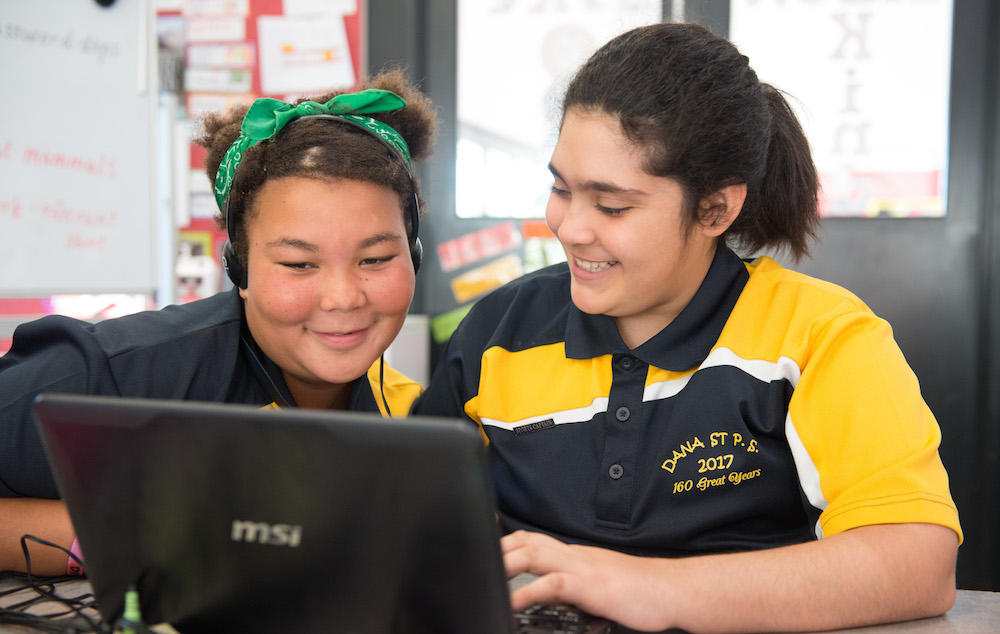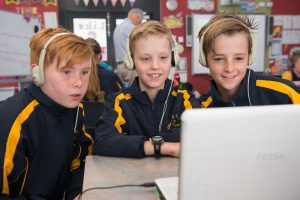Embracing e-learning in the 21st century classroom

According to demographers, if the parents of your 2017 prep cohort think they have the smartest kids ever, it’s not just parental bias. Professor of Demography and Director of the Australian Demographic and Social Research Institute, Peter McDonald, told reporters for www.news.com.au that ‘generation Alpha’, which began in 2010, will be the smartest generation so far: ”Their access to information is huge compared to the past, it is at their fingertips.”
It’s not all milk and skittles for these little treasures though; the research suggests they will be lonelier, spend more time in childcare and probably miss out on some family support. While they will probably require a good dose of those ‘social learning’ and ‘life skills’ priorities on everyone’s lips, they will not need you to show them how to use an iPad. They will probably be familiar with computer-based literacy and maths programs, and they may have a mish-mash accent from a variety of international content – educational and otherwise.
As always with this topic, resistance must be acknowledged for its utter futility; change with the times we must. The good news is the absolute array of educational benefits these programs can provide includes enhanced uptake of new concepts and considerable power to engage digital natives.
An August 2008 article released by the Queensland government in their journal, Smart Classroom Bytes, titled ‘Advice for schools on the latest information and communications technology (ICT) research for education’ was already arguing for a blurring of boundaries between curriculum and ICT, in order to effectively integrate the digital world into the classroom – as a context, rather than a discrete ‘computer studies’ course.
The document, which draws on and references considerable research, contextualises eLearning into a few main categories: digital pedagogy, digital content and eLearning spaces. The divisions pertain to how we teach, what we teach, and ‘where’ learning occurs. The report states that “these components co-exist to create the conditions for a new generation of digital learners. If one component is missing the approach is unbalanced and less effective”.
Almost a decade on, where are we with eLearning? You’d be hard pressed to find a prep class that didn’t at least flirt with an online learn-to-read program, while online memberships to maths and literacy programs are supplied to students for home and school use.
With so much on offer outside of the traditional ICT integrations, instead of waiting for it to be rolled out nationally, a famous Sir Ken Robinson directive might be relevant. He says if teachers or school communities want to see change in education, they should change what they’re doing in their own little world (read: classroom). “If enough people change their worlds, we change the world.”
A 2008 article titled ‘E-Learning pedagogy in the Primary School Classroom: the McDonaldization of Education’ published in the Australian Journal of Teacher Education, posed a sobering question: “If eLearning is the new medium deemed to provide a new form of social interaction why have we seen minimal changes to teachers’ pedagogical practices?” While this may have been the case in 2008, uptake of eLearning applications is strong in 2017. The authors also expressed concern that eLearning would come at a cost to the social contact of face-to-face teaching; that it would lead to the “homogenisation and dehumanisation” of primary education. This thesis will likely have proponents both for and against, yet the benefits of eLearning are notable. A paper by Zhang et al. published in Communications of the ACM (A publication for the Association of Computing Machinery) indicated that “in an e-learning environment that emphasizes learner-centred activity and system interactivity, remote learners can outperform traditional classroom students”.
What are the implications of this success? Why must the experiences of remote learners be applied to a classroom setting so face to face students can benefit? In 2013, the Digital Education Advisory Group (DEAG) released a report titled, ‘Beyond the Classroom: A New Digital Education for Young Australians in the 21st Century’, which argued, “the internet and digital technology are democratising content, enabling individuals to do many things that were once brokered by third parties (or not available at all).” Indeed, this concept has underpinned the work of Professor Sugata Mitra ever since his ‘hole in the wall’ experiment that provided access to the internet (and by extension, content for learning) to the slum-dwelling children in New Delhi.
The DEAG report says the challenge will be to extend students’ existing capacity to innovate through digital education. “Teachers, too, need the capacity to design and implement new ways of learning and should be supported in the development of innovative teaching practices underpinned by digital technology,” the report reads.
From foreign language learning and literacy to maths, architectural design, and biology programs, nearly everything is covered by digital content, and there is an interactive digital learning tool for most curriculum areas. Either synchronous or asynchronous, eLearning can engage a whole class simultaneously, or individually with differentiated practice.
The flipped classroom deserves a mention here. Class time and ‘student concentration tokens’ can be preserved by explaining the complex stuff in a YouTube video. Sydney maths teacher, and founder of Mister Wootube, Eddie Woo, is an excellent illustration of what a digital platform can do for maths. More at: www.misterwootube.com.
The benefits of eLearning tools are numerous, but some notable advantages include:
- Student engagement: interactive tools are enjoyable and speak the students’ digital native tongue.
- Flexibility: digital tools can be differentiated seamlessly for a mixed ability cohort; they can be set for homework in many cases; they are portable and ‘on tap’.
- Individualised learning: digital tools can be selected or manipulated to suit the learner. If the fit is still wrong, they can be discarded and replaced with a more suitable program at a low cost.
- Tracking progress: online learning tools and programs send reports of progress, making data collection and tracking a breeze.
An online tool for learning to love reading
 Ziptales is an online literacy resource designed specifically to get children hooked on reading. The extensive content – more than 300 stories, poems and puzzles – has been commissioned from authors all over the world, and arranged in genre categories for all levels of the New Zealand curriculum.
Ziptales is an online literacy resource designed specifically to get children hooked on reading. The extensive content – more than 300 stories, poems and puzzles – has been commissioned from authors all over the world, and arranged in genre categories for all levels of the New Zealand curriculum.
Founders Valerie and Richard McRoberts say they set up Ziptales to give children access to authentic literature so they could learn to love reading rather than being forced to read a text. “If the children don’t enjoy the reading, they’re not going to get it. The reward for reading needs to be intrinsic.”
Content includes deliberate categories for reluctant readers such as Scary, Yucky and True Tales, and all stories have voiceover to promote oral language development.
Schools can access Ziptales firstly through a 30-day trial and then through purchase of an annual licence. Regular professional development sessions are included. The program can be accessed on all devices and includes online worksheets which can be completed at home.
Technology to support teaching, not replace it
 During the past few years, teacher and parents have been deluged with new technological options for teaching, particularly for literacy and language teaching. A vast array of apps and programmes have appeared, many quite flashy looking and impressive sounding. However, there are several key principles to bear in mind when using technology.
During the past few years, teacher and parents have been deluged with new technological options for teaching, particularly for literacy and language teaching. A vast array of apps and programmes have appeared, many quite flashy looking and impressive sounding. However, there are several key principles to bear in mind when using technology.
- Technology needs to supplement and support teaching, not replace it.
- A well-designed programme should enable each learner to progress at his or her own speed
- A good program will also analyse each learner’s performance and create individualised reinforcement, as well as analytics for remedial and class teachers.
These are the key points of the New Zealand-developed literacy program, StepsWeb, which provides structured courses, but also the facility to create your own materials. You can enter any word, include a sentence and definition, and then record the word yourself – in any text-based language. In this way, you can customise the programme to an individual learner or adapt it to support any aspect of the curriculum.







